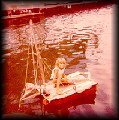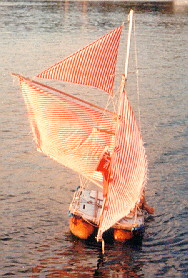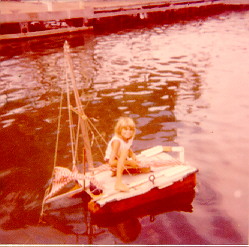

My First Boat
All sails set she was a fine sight as she sailed the waters of her home port of St. Georges, Grenada. In her fully evolved rig she was a gaff cutter. She carried five sails. Gaff mainsail, topsail, boom staysail, forsail out on the bowsprit and, for off wind runs a spinnaker lay bagged at the foot of her mast. Her mast carried a topmast, cross trees and a spinnaker pole. For windless days, a pair of sweeps lay in brackets on her deck. A little over six feet long, including her bowsprit, she had just enough room for a lad of ten.

Her catamaran hull was designed and constructed by my brother, while I made a smaller, not very successful trimaran. We had found an old dinghy and salvaged the expanded foam from between its double skin. As discoverer of the find, Graham took the two longer sections and used them as the twin hulls for a catamaran. He built a solid deck with some pitch pine planks, to which he fastened the reshaped foam hulls. He added the mast and basic sail. Meanwhile my efforts with my trimaran were far more rudimentary, soon to be discarded. After maiden voyages I did a deal with my brother to obtain his far sturdier craft. As I recall, the deal was two days use of my bicycle. Thus I was the proud owner of my new craft. Shortly after, we moved back to Grenada. I managed to persuade my father that my raft, as she became known, should go with us.

Back in Grenada, the harbour was perfect for such a craft. Although she sailed to windward surprisingly well, the beam wind made all the difference. Kim being anchored in mid harbour, my raft gave me the freedom to come and go as I pleased. No need to stand on the end of the marina docks and shriek the peculiar call we used to summon one of the family ashore with the dinghy. I roamed the harbour at will and became a regular sight and friend to all. Constantly on the scrounge, I added new features, made from whatever I could find. Friends from boats around the harbour contributed spares and ideas for her improvement. I experimented with different rigs.
My first donation was sail material, to replace the limp old bed sheets. A west indian friend, crew on a charter boat, called me over and gave me two nylon shower curtains. Red and white striped nylon, very light, they were perfect for the job. I soon persuaded my father to get the sewing machine out, fire up the generator and set to work. We made a spritsal rig and jib. Both were complete with re-enforced grommets in all the right places. Soon I was an even more visible sight on the lagoon. I added twin centre boards to improve windward sailing. Oarlocks, salvaged from an old rubber dinghy and nailed to the deck, replaced shoddy lashings.
By now I felt seaworthy enough and ventured out of the lagoon on my first long distance voyage. To town, to buy paint for her deck. The downwind journey was easy, out of the lagoon through the cut in the reef, past the cruise docks and across to the town itself. Tourists, lining the rails of an arriving cruise ship as I sailed past, threw pennies for the local kids to dive for and retrieve. Brown bodies flashed all around and I took evasive action to avoid their grabbing hands, reaching for my little ship. "Go away!", I cried, "This boat is only made for one!" The wind picked up and I left them astern.
The sail back from town was a bit more tricky. With my packets of nails and tins of paint carefully stowed at the foot of the mast, I tacked to and fro. Back up to the cruise ship, I tacked and I tacked. And I tacked again. Friends passed by in their outboard dinghies and hailed greetings as they made their shopping trips to town. The wind increased, and although I really didn't need to, I accepted a tow from another friend on his return journey. He towed me back to the lagoon, and donated a useful piece of rope to the cause.
My voyage had taught me a valuable lesson. The spritsail rig had to go. It just didn't perform to windward satisfactorily. Back at the drawing board, I realised that by turning the mailsail around, it became a good gaff main. I spurned the idea of a modern Bermuda rig. I changed the spars and added a top mast at the same time. Realising I needed more sail area I enlisted help to make a topsail. Getting quite carried away, we also added a boom staysail, its foot at the base of the bowsprit. I hauled her out on the dock, dried her out, and painted her decks baby blue. Some good friends, a couple on a small gaff cutter very similar to Riduna, made her a varnished wooden name plate that we fixed to her deck. We called her Bluebird. My mother sewed a little white masthead pennant, with a blue swallow motif. Everybody still called her "The Raft".

With all her improvements, she looked a treat, I journeyed to all points of the lagoon. With due regard to the rules of marine navigation, for sailing vessels under twenty metres, I added a masthead light for late night sails to and from the docks. To further improve her downwind performance, I prevailed upon my father again. We sewed a fine blue spinnaker and I fitted the spinnaker pole to her mast. Patiently, I would tack back and forwards across the harbour, each tack gaining me precious yards closer to the windward shore. Often I was hailed from anchored boats and I would sail over to greet old friend or new. To share a cold drink and a biscuit, before resuming my beat up harbour. Reaching the foreshore I would bear off the wind, raise the spinnaker, and soar down the harbour with every inch of canvas aloft. I wish I had a photo of that sight. My few photos seem to be all of the earlier spritsail rig. The downwind leg seemed to take seconds, compared to the long beat up. Down near the beach beside the marina screw lift, down came the spinnaker, in came the sheets and up I tacked again. Watching the cat's paws, the ripple of breeze on the water, I hoped for more wind next time. When there was no wind I would row, sitting on the deck with knees up and paddles tucking in under my skinny brown legs.

When at home my raft bobbed to her painter astern of Kim, sails tightly furled and lashed to her deck. One morning she was gone. Gone! I was frantic. This boat was my life. I scoured the lagoon but she was no-where to be found. Desperate, I rowed Kim's big dinghy over to the marina and walked the docks, explaining my loss and hoping for some clue as to her disappearance. There were none to be found. However, one of my friends, crew on a big charter yacht, hailed me over. Jumping in a powerful whaler, casting loose her lines, we gunned the motor and roared out of the marina. Having searched the lagoon already, we raced out through the cut and searched the Carenage, the outer, town harbour. Nothing. We planed out of the main harbour entrance, past the old statue, and along the coast. Along the reef just outside the entrance I spotted something in the surf and yelled, "Joey, over there, near the statue!" Joey brought the speeding whaler round in a gut wrenching turn and we thundered back to the coast. As we drew nearer, I recognised my precious boat, being pounded in the surf. Close in, I dived overboard and swam in. Making my way across the reef to where she lay wedged in the rocks, I surveyed the damage. The rudder was gone and the foam hulls chafed. But nothing too major, nothing I couldn't fix. Joey, who had been circling just beyond the reef, threw me a line and, gently, we dragged her back into clear water. Arrival in the lagoon was met by a few cheers as we towed my battered craft back in, my friends chiding me for my badly tied mooring line. May that be the last time, I sighed in relief.
************************

Page Hits Since November 20th 1997






